|
Carnivorous Plant Newsletter
Volume 16, Number 2, June 1987, pages 39-42; Front Cover
NEW CULTIVARS
Sarracenia x catesbaei 'Sun Warrior'
Sarracenla x catesbaei 'Carolina Cooler'
Sarracenia minor 'Dark Ladies'
Sarracenia x swaniana 'Friar Tuck'
Sarracenia x exornata 'Moore's Melody'
NEW CULTIVARS OF SARRACENIA
--- Larry Mellichamp • Charlotte, North Carolina • USA
--- Rob Gardner • Chapel Hill, North Carolina • USA
We are presenting here a five cultivars of species and hybrids from various sources (as indicated) that we have been observing and evaluating seriously for at least two full years. One should not select cultivars haphazardly; they must prove themselves to be outstanding plants and the evaluator must consider the criteria carefully. Our evaluation criteria consisted of a consideration of:
Plant habit: good growth form with the leaves stiffly erect, not affected by wind or rain.
Plant size: was it compact; could it be grown under lights or in a small terrarium.
Leaf coloration: was there distinctive venation, good colors, interesting contrasts, a fall color change, etc.
Winter form: did the leaves retain color and substance better than average under cold but non-freezing winter dormancy.
Propagation: was the plant a vigorous grower, easy to divide.
Leaf production: was it constant, or seasonal.
Flowers: were they attractive, were they fragrant.
These were the main criteria; of course, not every specimen rated highest in all categories, but they had to be above average in some important characteristics.
The new selections that we are describing and registering here are, to our knowledge, the first Sarracenia cultivars designated in the United States. Our aim is to have them propagated commercially and make them available inexpensively to collectors in the near future. Please do not inquire about them now unless you are willing to pay a great deal of money for a division!
Photographs and herbarium specimens of these cultivars have been deposited in the herbarium of the University of North Carolina at Charlotte (UNCC). All cultivars have been grown and tested at one or (in almost all cases) both authors' institutions. These particular hybrids are known to occur in the wild, and have already been named (See Bell 1952, Pietropaolo 1986, and Schnell 1976 for more information on the hybrid names). Photographs of each cultivar are presented here also, though the colors may not necessarily have reproduced true to life.
Sarracenia x catesbaei 'Sun Warrior'
A selection of the well-known hybrid between S. flava and S. purpurea. It originated as a seedling from open-pollinated parents (presumably of wild North Carolina specimens) at the North Carolina Botanical Garden (NCBG) before 1983. The plant has made several leads and has retained its compact size while producing new leaves 6-7" high throughout the season. They do not last well into the winter, however. The pitchers have richly colored red tubes and the hood is distinctly red-veined. The throat is especially dark red. The flowers have not been seen.
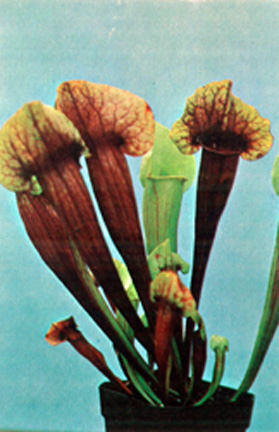
Figure 1: Sarracenia x catesbaei cv. 'Sun Warrior.' Photo by TL Mellichamp.
Sarracenia x catesbaei 'Carolina Cooler'.
A selection originating from the same batch of open-pollinated seeds as 'Sun Warrior.' It is growing well, maintaining its small habit, and producing 5-6" leaves throughout the season. They, too, do not last well into winter. The pitcher color is much less suffused with red. The tube, and especially the hood, have varying tones of green and yellow-green underlying the distinctive red veins, giving a refreshing appearance.
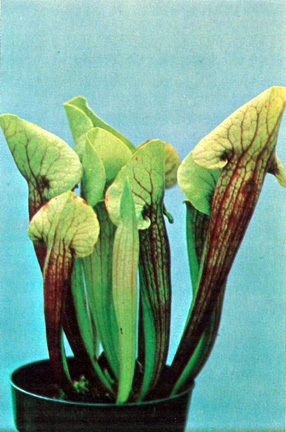
Figure 2: Sarracenia x catesbaei cv. 'Carolina Cooler'. Photo by TL Mellichamp.
Sarracenia minor 'Dark Ladies'
This plant was selected from among seedlings grown at the North Carolina Botanical Garden from wild-collected seed. The seeds came from Brunswick County, North Carolina. The pitchers are 6-8" high and are typical in shape for the species, though they are a bit more slender. The aereolae are very distinctive. The most unusual aspect is the very dark red coloration of the hood, inside and outside. New pitchers are formed throughout the growing season, but they do not hold up well into the winter.
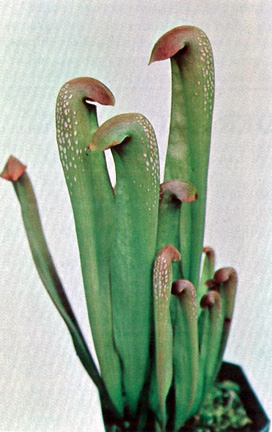
Figure 3: Sarracenia minor cv. 'Dark Ladies'. Photo by TL Mellichamp
Sarracenia x swaniana 'Friar Tuck'
This delightful little cultivar originated as a seedling from a batch of wild-collected seed (Brunswick Co., N.C.) taken from a plant identified as straight S. minor. Obviously cross-pollination had occurred with S. purpurea. The seedlings were grown at the NCBG. The leaves are about 5", high, richly colored red outside above, with dark veins on the unusually smooth-margined hoods (such hybrids have hoods that are distinctly more wavy, after the S. purpurea parent). The hoods are also a little flatter in side view than usual, with an upturned tip. There are subtle shades of color in the hoods, making this cultivar attractive and distinctive. The leaves look good all season, and do not turn brown completely in winter.
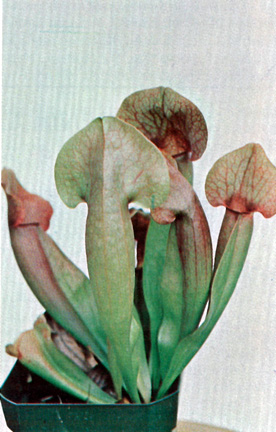
Figure 4: Sarracenia x swaniana cv. 'Friar Tuck'. Photo by TL Mellichamp.
Sarracenia x exornata 'Moore's Melody'
This large, robust plant was collected in the wild in southeastern Mississippi in 1985 by Mr. J.C. Moore, Sr. of Mobile, Alabama and sent to Larry Mellichamp at UNCC. We have named the cultivar after the musically talented collector who has been very instrumental in discovering unusual pitcher plants in the Mobile area. The plant appears to be a hybrid between S. alata and S. purpurea venosa (undoubtedly the "Louis Burk" pink-flowered form ), both of which grow in the vicinity but ,do not hybridize commonly. Stout, firm-textured pitchers about 6-9" high are produced throughout the growing season. They taper gradually from bottom to top to produce a broad cone with very wide slightly wavy-margined erect hoods. As the pitchers grow and mature they show various colors. The colors are intricate and subtle, yet rich and interesting with predominately maroons and oranges as a background for dark red veins. There are no aereolae (or light windows) evident as there would be if S. leucophylla were involved in the hybrid. The flower is also very large and attractive, somewhat orange-pink in color. We have already used this cultivar in cross-pollination with other attractive specimens.
The most important feature of this hybrid is the fact that the pitchers remain fully intact and colorful throughout the winter in an unheated greenhouse where temperatures occasionally go just below freezing. Since most Sarracenias die down in winter, we believe this is an exciting characteristic to use in breeding plants that look good year around. So far the plant appears vigorous, and it looks like it is going to become even larger.
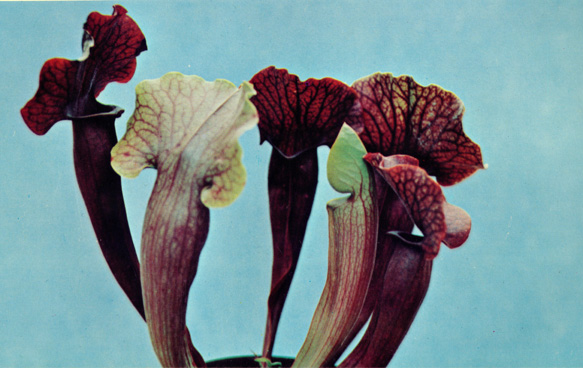
Front Cover: Sarracenia x exornata 'Moore's Melody', a new cultivar of Sarracenia. Photo by TL Mellichamp.
References cited:
Bell, C.R. 1952. Natural Hybrids of the genus Sarracenia . Journal of the Mitchell Society 68:55-80. [A classic]
Pietropaolo, James and Patricia. 1986. Carnivorous Plants of the World. Timber Press, Portland, Oregon. 206 pages. [brand new attractive book]
Schnell, D. E. 1976. Carnivorous Plants of the United States and Canada. Blair, Winston-Salem, N.C. 125 pages. [best manual on native CP]
Note: The US Fish and Wildlife (USFW) -Office of Scientific Authority is considering listing all Sarracenia species on Appendix II of CITES.
|

